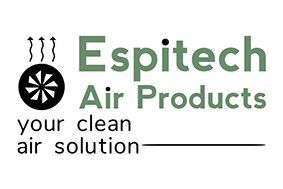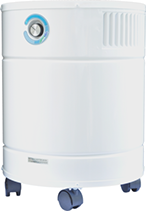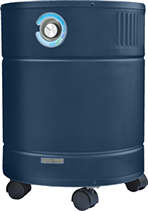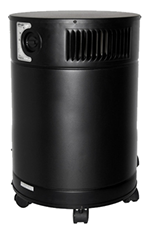Allergy and Asthma Air Purifiers

Air Purifiers for Asthma and Allergies
| Applications | Why Allerair | Air Purifier Models - Series | Filtration Guarantee |
Allergic asthma or extrinsic asthma is the most common type of asthma and typically develops in childhood. 80% of children with asthma also have documented allergies and, typically, a family history of allergies.
Many people are not sure when it comes to spring allergies, whether they should keep their windows open or closed. It is important to note that an air purifier is one part of your allergy control plan. Pollen, for example, is heavy and falls to the floor or gets stuck on furniture before an air purifier has enough time to catch them. It helps to dust and clean your rooms and possibly rearranging furniture in order for your home to be more allergy friendly.
Steam cleaners for chemical free free cleaning, washing sheets in hot water above 140° or a dehumidifier to control levels of mold and dust mite growth are remedial actions that help work alongside an air purifier in your overall allergy action plan.
High efficiency particle, gas and odor air filtration, particularly in a child’s bedroom, may be a useful precaution and help prevent the onset of the sensitizing exposure early in life. Another fact to consider is that clean air increases productivity levels of children in school.
Both airborne chemicals and particles aggravate, and in some cases, may even trigger allergies and asthma. It is therefore vital that an air cleaner for respiratory conditions provides a dual approach with both a deep-bed activated carbon filter and Super HEPA filter.
Often physicians will use the term "reactive airway disease" when they might suspect that asthma is a possibility but can’t provide a definitive diagnosis. For young children under the age of six, tests to prove asthma are usually not accurate. That’s because the tests to measure lung function involve measuring how quickly and how much air your child can exhale. Young children often have trouble regulating their breath and following the instructions required for an accurate test.
Your pediatrician will likely consider the type of symptoms, how often they occur and how severe they are when trying to make their diagnosis. There are unfortunately many conditions that cause coughing, wheezing or shortness of breath. To make diagnosis even more complicated, some of those conditions will trigger or co-exist with asthma. These include things like allergies, airway abnormalities, respiratory tract infections and even acid reflux. Regardless of the exact diagnosis there are a few things parents can do to help children with sensitive airways and most of them start with the air they breathe.
Indoor air in most cases is surprisingly worse that outdoor air in terms of overall air quality and breath-ability. The cause lies in our expertly insulated homes that don’t allow for a good exchange of air. That means we're breathing in a collection of all the pollutants found in our homes and there are far more than most of us realize.
Common Allergy and Asthma Triggers:
Triggers are substances that, when inhaled, set off an allergic reaction or an asthma attack.
Chemicals and Odors
Chemicals and odors are often overlooked as a major trigger, even by doctors. Yet more and more studies are linking the numerous chemicals we encounter every day to breathing difficulties, heart problems and even cancer. According to the Natural Resources Defense Council, more than 80,000 of the chemicals currently used in the U.S. have not been adequately tested for their effects on human health and longevity. Now just think of all the cleaners, sprays, paints, glues and other chemicals we use and store in our homes. Then consider all the other items that off-gas chemicals: furniture, flooring, shower curtains, mattresses, dry-cleaning, packaging, home electronics – the list is endless. Sadly all these products contribute to poor indoor air quality that can trigger allergies, affect sensitive lungs, even cause long-term harm to growing bodies.
Dust
One of the more well-known triggers is household dust. While less frightening than airborne chemicals, dust can also act as a trigger for sensitive airways. Many doctors will ask parents about things like carpeting, stuffed toys and other items in your child’s bedroom that may help trap dust and trigger allergies, asthma or asthma-like symptoms.
Pets
This is a hard conversation that many pediatricians will have with parents of children who have airways issues. Kids who have breathing conditions frequently have allergies to pets. Many people think that the animal’s fur or feathers are the cause, but it’s actually the dander or microscopic flecks of skin shed by cats, dogs, rabbits, hamsters, birds and other common pets. That’s why there can be no such thing as a hypoallergenic animal – because they all shed skin. In recent years some dog breeds have been marketed as causing fewer symptoms than others. These animals either don’t shed their fur or shed very little so the dander that sticks to that fur won’t spread around as much as other breeds.
Clearing the Air
An action plan developed with your doctor and avoiding triggers are most immediate ways to help a child with sensitive airways.
Here are a few tips that could help clear the air:
- Use an air purifier with a deep-bed carbon filter for chemicals and a particle filter Super HEPA to remove triggers that might be airborne
- Change the filter in your furnace or air exchanger regularly to reduce dust in your ducting
- Clean with a sealed vacuum that won’t redistribute dust
- Reduce your chemical use by switching to more natural cleaning products or ones you can make at home.
Here are some AllerAir Air Purifiers, Air Filtration Systems recommended:
| Home | Home & Office | Industrial & Commercial | FAQ | About Us | Contact Us |
| AllerAir Price List | Electrocorp Price List |
* Free Ground, Standard Shipping to the Continental US and Canada / Specs & Prices subject to change without prior notice | Call to order your replacement filters
Electrocorp Air Rhino Air Scrubbers- https://www.airwashsystems.com
© 1996-2024Produits D'Air Espitech, SENC ( Espitech Air Products) All Rights Reserved. All pages and their content are provided as information only. Use of this online service is subject to the disclaimer and the terms and conditions.






